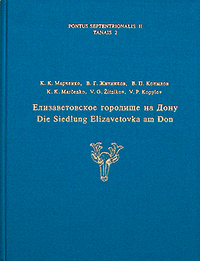|
|
|
|
|
| AUTHOR: |
|
Konstantin K. Marčenko, Viktor G. Žitnikov,
Viktor P. Kopylov
Константин К. Марченко,
Виктор Г. Житников, Виктор П. Копылов
|
|
| |
| TITLE: |
|
Die Siedlung Elizavetovka am Don
Елизаветинское
городище на Дону |
| |
| SERIES: |
|
Pontus Septentrionalis
II, Tanais 2 |
| |
| PUBLISHER: |
|
Paleograph Press;
Deutsches Archäologisches Institut;
Institute of Arcaeokogy, Russian Academy of Sciences
Center for Comparative Study on Ancient Civilizations,
Russian Academy of Sciences
|
| |
| YEAR: |
|
Moskau, 2000 |
| |
| LANGUAGE: |
|
Bilingual Edition (in
German and in Russian) |
| |
| ISBN: |
|
5-89526-006-3 |
| |
| FORMAT: |
|
22 × 29 cm |
| |
| PAPER: |
|
Text part — Offset paper,
120 gramm;
Plates — Coated paper, 135 gram |
| |
| COVER: |
|
Hardcover, cloth
|
|

|
| PAGES: |
|
356
pages, including 12 text illustrations and
72 plates with 126 b/w photographs |
| |
| WEIGHT: |
|
3 kg |
| |
| PRICE: |
|
46.00
Euro / 62.00 US $ (+postage)
41.00 Euro / 55.00 US $ (+postage)
with the subscription to at least three volumes of Pontus Septentrionalis (with the 10%
discount for each volume) |
|
***
The Elizavetovka settlement located on the Don
river is one of the largest settlements of the early iron period
discovered in the steppe zone of the northern seaboard
of the Black Sea. Its location at the junction of the three large
ethnic groups (Scythians, Sauromats (Sarmats) and Meotes), the
proximity of the Hellenic cities of Bosporan Kingdom, as well
as the presence of convenient river and sea transport routes and
rich natural resources of Don river contributed to making Elizavetovka
the largest center of inner-tribal and international trade in
the whole South Eastern part of Gerodot Scythia. No other settlement
in the northern seaboard of the Black Sea from the Scythian period
provides us with better means of understanding the process of
the origin and development of barbarism, especially Hellenic-barbaric
contacts.
By the middle of IV AD, Elizavetovka became a settlement with
basic trade, administrative, religious and shelter functions.
The functions that this settlement performed make it possible
to view it as a capital of the whole Lower Don region and, partially,
of the North Eastern Azov region. As a result of archaeological
excavations conducted for many years by a Southern Don expedition,
enormous and unique archaeological material has been obtained.
The volume describes architectural and fortification complexes and privides a detailed analysis of the material culture of the inhabitants of Elizavetovka settlement at the different stages of its development, from the time when it was founded and its first direct cultural and economic contacts with the Greeks were established, up to the time when the city was destroyed, and a large Bosporan colony was founded on its ruins.
Table of Contents:
| Einleitung. |
9 |
Kapitel 1. Archäologische Forschungsgeschichte. |
13 |
| Kapitel 2. Paläogeographie des Don-Deltas, opographie
und Stratigraphie der Elizavetovka-Siedlung. |
31 |
| Kapitel 3. Chronologie und Periodisierung der Geschichte
der Elizavetovka-Siedlung. |
55 |
| Kapitel 4. Die Verteidigungsanlagen. |
16 |
| Kapitel 5. Die Architekturkomplexe der einheimischen Bevölkerung
(Wohn- und Wirtschaftsbauten). |
93 |
| Kapitel 6. Der keramische Komplex. |
133 |
| Kapitel 7. Die Wirtschaft (Viehzucht, Ackerbau, Fischfang,
Jagd, Handwerk und Hausgewerbe, Handel). |
167 |
| Kapitel 8. Die Kurgannekropole von Elizavetovka. |
215 |
| Kapitel 9. Kulturhistorische Bemerkungen und Schlußfolgerungen. |
229 |
| Kapitel 10. Die griechischen Niederlassungen auf dem Territorium
der Elizavetovka-Siedlung. |
249 |
| Literaturverzeichnis. |
264 |
| Abkürzungsverzeichnis. |
273 |
| Abbildungsverzeichnis. |
275 |
Tafeln 1–72. |
283 |
Sample Screenshots:
Plates 52–53.
Plates 62–63.
Sample Downloads:
Other volumes of Pontus Septentrionalis :
|
|